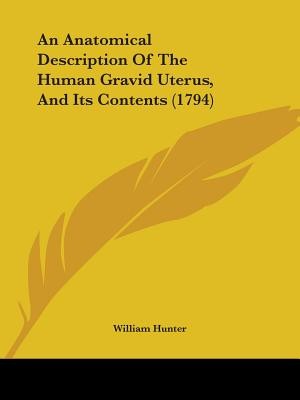
- We will send in 10–14 business days.
- Author: William Hunter
- Publisher: Kessinger Publishing
- ISBN-10: 1437477801
- ISBN-13: 9781437477801
- Format: 21 x 27.9 x 0.5 cm, softcover
- Language: English
- SAVE -10% with code: EXTRA
An Anatomical Description Of The Human Gravid Uterus, And Its Contents (1794) (e-book) (used book) | bookbook.eu
Reviews
Description
This historic book may have numerous typos and missing text. Purchasers can download a free scanned copy of the original book (without typos) from the publisher. Not indexed. Not illustrated. 1843 Excerpt: ...into which the arteries terminate, and from which the veins begin. Though the placenta be completely filled with any injection thrown into the uterine vessels, none of the wax finds its way into any of the umbilical vessels; and, in the same manner, fluids injected into the umbilical vessels never can be-pushed into the uterine, except by rupture or transudation. The first time (in the year 1743) that I injected the vein of the navel-string while the placenta adhered to the uterus, in separating these two parts it was evident that the injection had no where passed further than the placenta, except at one place, where a small convoluted vessel (no doubt an artery) was traced, distinctly filled with wax, some little way into the substance of the uterus; but upon examination it was evident that there was extravasation in that part of the placenta, and by many trials I know that water, or any fluid fit for transudation, thrown into the umbilical arteries or veins, readily gets into the cellular cavities of the placenta, and thence into the vessels, especially the veins of the uterus. In some recently published observations on the structure of the placenta, by Dr. Reid of St. Andrews, he has shown that the extreme branches of the umbilical vessels, consisting of their arteries and corresponding veins, are encased or bound together by a membrane which is continuous with the inner coat of the vascular system of the mother. "I was satisfied," says Dr. Reid, "that each of the smaller branches of the placental arteries is bound up with another branch of one of the placental veins, which closely accompanies it, forming what appears to be a single vessel when viewed through the microscope. Each branch of the umbilical artery is thus closely bound up with...
EXTRA 10 % discount with code: EXTRA
The promotion ends in 20d.18:55:11
The discount code is valid when purchasing from 10 €. Discounts do not stack.
- Author: William Hunter
- Publisher: Kessinger Publishing
- ISBN-10: 1437477801
- ISBN-13: 9781437477801
- Format: 21 x 27.9 x 0.5 cm, softcover
- Language: English English
This historic book may have numerous typos and missing text. Purchasers can download a free scanned copy of the original book (without typos) from the publisher. Not indexed. Not illustrated. 1843 Excerpt: ...into which the arteries terminate, and from which the veins begin. Though the placenta be completely filled with any injection thrown into the uterine vessels, none of the wax finds its way into any of the umbilical vessels; and, in the same manner, fluids injected into the umbilical vessels never can be-pushed into the uterine, except by rupture or transudation. The first time (in the year 1743) that I injected the vein of the navel-string while the placenta adhered to the uterus, in separating these two parts it was evident that the injection had no where passed further than the placenta, except at one place, where a small convoluted vessel (no doubt an artery) was traced, distinctly filled with wax, some little way into the substance of the uterus; but upon examination it was evident that there was extravasation in that part of the placenta, and by many trials I know that water, or any fluid fit for transudation, thrown into the umbilical arteries or veins, readily gets into the cellular cavities of the placenta, and thence into the vessels, especially the veins of the uterus. In some recently published observations on the structure of the placenta, by Dr. Reid of St. Andrews, he has shown that the extreme branches of the umbilical vessels, consisting of their arteries and corresponding veins, are encased or bound together by a membrane which is continuous with the inner coat of the vascular system of the mother. "I was satisfied," says Dr. Reid, "that each of the smaller branches of the placental arteries is bound up with another branch of one of the placental veins, which closely accompanies it, forming what appears to be a single vessel when viewed through the microscope. Each branch of the umbilical artery is thus closely bound up with...


Reviews